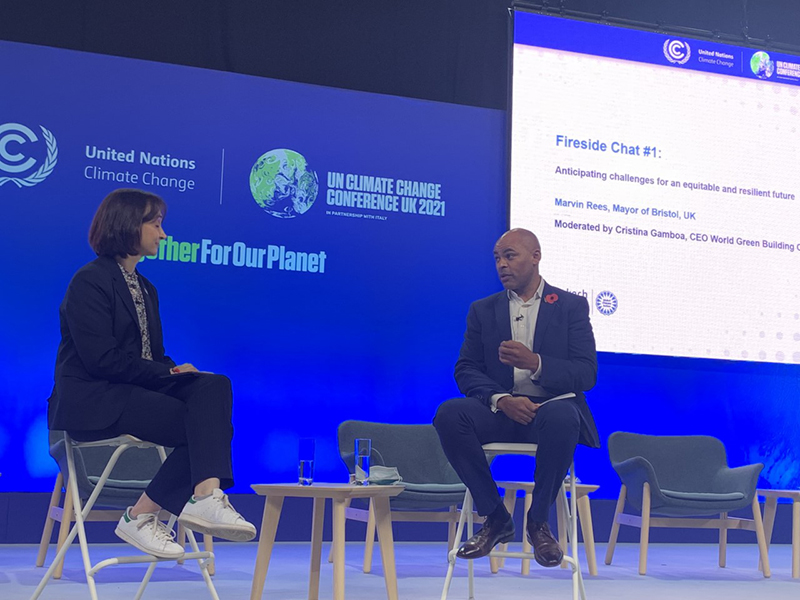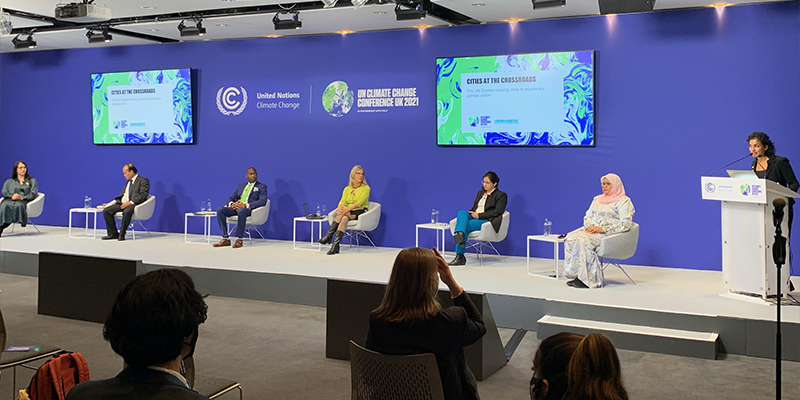For the second and final week of the 26th UN Climate Change Conference of the Parties (COP26) in Glasgow, Scotland, Penn IUR joined the Penn delegation with representation from Amy Montgomery, Penn IUR’s Managing Director. She provided daily bulletins on urban-related activity from COP, which are arranged below in reverse chronological order.
Thursday, November 11

Penn IUR Urban Leadership Awardee Marvin Rees, Mayor of Bristol, England, speaking at the event "Decarbonizing and Adapting our Built Environment and Cities."
At today’s Action Event, “Decarbonizing and Adapting our Built Environment and Cities,” a key programmatic component of COP26’s Cities, Regions and Built Environment Day, Marvin Rees, Mayor of Bristol, England, said succinctly what so many have been saying all week: “Climate change will be won or lost in cities.” Fifty percent of the global population currently lives in cities, and that is estimated to increase to 68 percent by 2050. By all accounts, urban communities are essential to achieving the necessary carbon reductions to achieve net zero by 2050.
Around the world, subnational leaders like mayors and governors are implementing plans to reduce carbon emissions over the next decade or two. As Mayor Rees, a 2021 Penn IUR Urban Leadership Awardee, articulated, cities are also experiencing the acute effects of the COVID economic crisis and climate- and social unrest-related immigration. Cities are often attempting to systemically address these crises in tandem (earlier this week, Mayor Rees authored an article in the Economist detailing how mayors are leading the fight against climate change).
Minna Arve, Mayor of Turku, Finland, in sharing her city’s plan to build a circular economy and achieve carbon neutrality by 2029, said “It’s not what we promise, it’s what we do.” Likewise, Pamela Escobar Vargas, of Mexico City and the C40 Global Youth and Mayor’s Forum, voiced the Forum’s demands and put a fine point on it: a just transition “is not talked about, it is demonstrated. If leaders don’t commit to radical change, they are supporting a system of death.”
David Ige, Governor of Hawaii, said “achieving net zero is not enough.” Hawaii is the first U.S. state to commit to 100 percent clean and renewable energy and reaching net-negative by 2045. He said that nature-based solutions (NBS) and science-based policies are central to creating an economy and environment that allow people to thrive, especially low-income communities who have long shouldered an unfair share of environmental burdens. In Hawaii, like many places, oil and coal plants are located in low-income areas. Next year, Hawaii will retire their last coal plant and replace it with solar and battery storage. He shared this as an example of a solution that is not only healthier, but also more affordable, demonstrating how decarbonization strategies can address multiple socio-economic dimensions.
Similarly, Claudio Castro, Mayor of Renca, Chile, a municipality of Santiago, said that addressing both social and environmental inequities is necessary to build the sustainable future residents deserve. Renca struggles with environmental inequalities such as urban heat island effect and pollution. Renca is making strides to ensure a healthier future for citizens—it is retiring two power plants located in the municipality, tackling a long-standing problem with street waste, and mobilizing residents to engage in citizen science initiatives, while also aiming to create new park space. Community participation is key, nationally and locally. On the national level, citizens are involved in the effort to build a new constitution, with equity being a central theme. Mayor Castro’s hope is that the new constitution results in decentralization and brings power closer to the people, ultimately serving as an example for other countries. Local engagement is exemplified by the citizen science effort to measure air quality, which found 23 critical air events in the past year—five more than what Santiago had recorded.
Mayor Rees urged that any announcements and commitments coming out of COP need to be tied to real places, real money, and real dates. Commitments also need to address the challenges that mayors face in accessing essential financing. The money, he said, needs to be spent on two key efforts: 1) infrastructure to decarbonize and 2) good urban planning, as “bad urbanization is a big problem and good urbanization is a great solution.”
Mauricio Rodas, former Mayor of Quito, Ecuador and Visiting Fellow at Penn IUR, Perry World House, and the Kleinman Center for Energy Policy and leader of the City Climate-Resilient Infrastructure Financing Initiative, along with other experts, explored the lynchpin issue of financing in the session “Building Ambition: Scaling Finance for Sustainable Cities,” hosted by Chatham House. Key points of this session included:
- The need for reliable and consistent data to assess the life-cycle emissions of climate investments and to track their performance. Providing reliable data on how investments perform will help inform and encourage future investments.
- Supply is not the problem. There are committed financial resources that are not being deployed because of lack of demand, all while need is rapidly increasing. To increase demand and the number of bankable projects, we need to increase cities’ ability to secure financing. In many countries, cities can’t borrow money from multilateral development banks without a national guarantee. In countries where cities can directly access this financing, they may face other hurdles like project preparedness. Cities often have difficulty establishing or increasing creditworthiness. Of the 500 largest cities in the world, only 20% are creditworthy; small- to medium-sized cities face even more barriers. We also need to increase the ability of cities to navigate sophisticated financial ecosystems.
- Cities often sit within complex regulatory environments established by their national governments. International financial institutions (IFIs) should develop clear and consistent mandates that the climate financing they provide to national governments needs to be deployed to cities. This is happening in Colombia, where the International Development Bank (IDB) is providing financing to the Colombia Development Bank with clear requirements on how to direct money which might otherwise be influenced by political factors.
- Cities and investors need to speak the same language and understand what each is looking for. The EU sustainable finance taxonomy is a step in this direction (many development banks don’t even have an “urban” tag for projects).
There is a great deal of well-earned criticism of COP26 and the conferences that have preceded it (for more, see recent articles in the New Yorker and Washington Post). However, it seems that many participants agree that COP26 is noticeably more focused on action and implementation than previous conferences, if insufficiently so. A key challenge on which there appears to be consensus is that goal setting, planning and project implementation, and progress reporting need to be consistent (across member states as well as subnational governments like cities) and transparent.
Tomorrow, the official proceedings of COP26 draw to a close. Regardless of the final agreements and commitments by member states, it is evident that what happens in cities will shape our planetary future.
Wednesday, November 10

The event "Scaling Up: Case Studies in Collaborations between Cities and Higher Education Institutions,” featuring speakers from the Urban Climate Change Research Network and the University Climate Change Coalition.
I kicked off COP26’s Transport Day by attending the C40 Cities and International Transport Workers' Federation (ITF) global roundtable, “Acting Locally, Acting Globally for Public Transport,” on safe, affordable, equitable, and accessible public transportation.
The event built on the organizations’ joint campaign, The Future is Public Transport, and its recently released report, “Making COP26 Count: How investing in public transport this decade can protect our jobs, our climate, our future,” which calls on “the world’s governments to prioritise sustainable long-term investment in public transport or risk climate breakdown.”
The moderator, Kamal Ahmed, Editor-in-Chief and co-founder of the News Movement, kicked off the event with a quote from Enrique Peñalosa, former Mayor of Bogotá: “An advanced city is not one where even the poor use cars, but rather one where even the rich use public transport.” C40 Cities Vice-Chair and Governor of Jakarta, Anies Rasyid Baswedan, introduced the campaign and report, arguing that investing in public transportation is good for the planet and people. “It is necessary to collectively double the share of journeys taken by public transport in cities by 2030 to deliver on the IPCC goal to halve emissions this decade and limit the global temperature rise to 1.5°C. Switching to electric cars is essential, but not enough. Public transport is not simply about moving individuals to one place to another, it is about connecting people. It is public transport that unites us. Every person living in an urban area should have access to safe, frequent, affordable, and accessible public transport within a 10 minute walk from their home.”
Sharan Burrow, General Secretary of the International Trade Union Confederation, followed, saying: “We know we have to transition in every sector. Cities are a big part of that equation. We know that cities are a big part of the answer. If we're going to create livable and affordable cities, then public transport is part of the action.”
Mayors, transportation workers, and activists from the cities of Seoul, London, Glasgow, Toronto, Barcelona, Jakarta, Santiago, São Paulo, and countries including the Philippines, Kenya, and Germany all spoke to the importance of robust, safe, and inclusive public transportation systems to support the livelihoods of residents and workers and the transition to net zero.
A number of other events, virtual and in-person, addressed climate action in cities around the world:
- The Organisation for Economic Co-operation and Development (OECD) and the Cities Climate Finance Leadership Alliance (CCFLA, a partner organization in the City Climate-Resilient Infrastructure Financing Initiative) hosted the event “Financing climate action in cities and regions,” which explored how subnational budgets, now focused on a post-COVID green recovery, are aligning with climate objectives. Speakers included national and subnational policy-makers, climate and public finance experts, and private sector stakeholders from across the globe, who discussed instruments for budgeting, tracking subnational climate financing, and ensuring accountability.
CCFLA’s “2021 State of Cities Climate Finance Report” served as background for the discussion. The report examines the current state of urban climate investment, the barriers to reaching the needed investment levels to mobilize city level climate finance at scale by 2030, and the steps to overcoming these challenges. Speakers also referenced two place-based reports from CCFLA: “Assessing Jakarta’s Climate Investments” and “A Snapshot of Urban Green Finance in Two Indian Cities.”
- The World Resources Institute (WRI) held a virtual event, “Financing innovative nature-based solutions (NBS) in cities: Lessons learned for the next generation of urban NBS projects.” Speakers from the cities of Athens and Vienna shared specific cases of urban NBS, and speakers from the European Investment Bank (EIB), the European Commission, WRI, and ICLEI discussed how cities and funders can move from the testing phase to integrating NBS more systematically into overall urban planning and project implementation. They discussed how to leverage mechanisms, such as the Natural Capital Financing Facility (NCFF), to support projects that use NBS for climate adaptation and/or biodiversity benefits that generate revenues or demonstrate cost savings.
Doris Schnepf, Managing Director, Green4Cities, said the most promising financing models for NBS are “impact bonds, as a promising financial instrument for complex climate measures in public spaces at scale, and revolving funds, as a promising opportunity to create local ownership and multiply invented capital towards social innovation and cohesion.”
Holger Robrecht, Deputy Regional Director, Sustainable Resources, Climate & Resilience, ICLEI European Secretariat, shared with participants that a recent report by CDP (a not-for-profit charity that runs the global disclosure system for investors, companies, cities, states, and regions to manage their environmental impacts) on financing sustainable infrastructure in cities analyzed 165 projects (reported by 58 European cities) and found that “most urban projects related to climate are small to medium size (i.e. up to 2-3 million euros) . . . and often don’t make it beyond the initial stages of feasibility assessment, suggesting that conditions for funding don’t match the needs of the cities’ projects.”
The event recording will be made available here.
- “Scaling Up: Case Studies in Collaborations between Cities and Higher Education Institutions” was an official in-person side event. Speakers from the Urban Climate Change Research Network and the University Climate Change Coalition, representing universities in the U.S., Australia, the Bahamas, and Italy, shared their experiences working directly with cities to understand local climate-related changes and implementing direct climate actions.
Key takeaways included:
- Research is a key component to on-the-ground climate projects for making learning transferable, replicable, and scalable.
- Universities play a unique role in climate action in that they can provide non-partisan expertise to both governments (in shaping data-informed policies and preparing for negotiations such as COP, for example) and citizens (including helping to organize citizen science efforts).
- Universities are shaping the next generation of climate leaders, developing knowledge that can transform society, and creating opportunities to solve problems and test solutions with real-world partners. In many cases, external partners are often more open to hearing recommendations from students than from faculty, which gives the students a unique opportunity to effect change while also advancing university-based research efforts.
- In working to decarbonize campus operations, universities are able to pass on their learnings to local governments.
- Penn alum Rachel Valleta, Environmental Scientist at Philadelphia’s Franklin Institute, emphasized the need for universities to ground their research in their surrounding communities, producing tangible and useful information.
- There are challenges to academic climate research. Namely, that the commitments coming out of CO26 are centered on projects, not research.
Tuesday, November 9

The session "UN-Habitat: Cities at the Crossroads—The UN System helping cities to accelerate climate action,” featuring Maimunah Mohd Sharif, Diana Ürge-Vorsatz, Simone Sandholz, Errick D. Simmons, and other expert speakers.
Today, the United Nations Human Settlements Programme (UN-Habitat) hosted the discussion, “UN-Habitat: Cities at the Crossroads—The UN System helping cities to accelerate climate action.” The stated purpose of the session was “to showcase ‘One UN’ action in the following focus areas: mainstreaming urban climate action into national policies and building local capacities for informed climate action.”
Maimunah Mohd Sharif, Executive Director, UN-Habitat, set the stage for the conversation by stressing the importance of helping cities around the world implement innovative new practices to address climate change like urban forestry programs, local procurement practices, and developing clean air action plans. She emphasized the need to unlock the climate financing necessary to make these programs widespread and spotlighted the Adaptation Fund, which has been created to help the poorest settlements build climate resilience. UN-Habitat has recently reviewed the nationally determined contributions (NDCs) for their urban content and found that cities have featured much more prominently over the past five years, but still many member states need to capitalize on the low-hanging fruit represented by prioritizing the decarbonization of cities. She urged that this issue be the focus of a future IPCC report on cities and climate change.
Other highlights from this discussion included:
- Dr. Diana Ürge-Vorsatz, Vice-Chair, Working Group III, Intergovernmental Panel on Climate Change (IPCC), shared how cities, which are on the front lines of climate change, can and often do pilot innovative tactics for addressing climate change that can affect national policies. For example, cities are mandating ambitious building codes for energy efficiency, often starting by mandating these new codes for all public buildings. As the local construction industry begins to adapt, these standards are broadened into wider mandates and incentives for building efficiency in other sectors. Similarly, cities are reallocating urban space from roads to bike lanes and pedestrian areas, which has significant implications for emissions. National governments need to protect these local achievements by cementing them in national policy. A more surprising mechanism cities are using to catalyze national action is climate emergency declarations. This past June, the IPCC conducted a review which found that over 2,000 subnational governments have declared climate emergencies. National governments have been incentivized by such declarations, unlocking resources for the affected localities and taking more aggressive climate measures. The IPCC review also found that 13 percent of the global population was in climate emergency status.
- Dr. Simone Sandholz, Academic Officer and Head, Urban Futures and Sustainability Transformation (FAST) Programme, United Nations University (UNU), stressed the need for climate-related data that allows cities to make informed decisions that acknowledge that cities are made up of interconnected systems. It is important that the decisions cities make now when investing in infrastructure (water, transport, etc.) be based on what cities will look like in the future, and therefore, cities need access to future climate scenarios. The data and scenario planning, most importantly, need to be centered on people (with every city having unique population-based needs—aging populations, low income populations, etc.), and need to address how people live together and the informal elements of cities, which are fundamental to how cities function. She suggested that systems thinking is paramount at this time—crises are interconnected, and depending on a city’s approach, they can either exacerbate one another or be mutually resolved. Physical and social data need to be considered together, as do adaptation and mitigation strategies.
- Errick D. Simmons, Mayor, Greenville, Mississippi, shared his experience governing a city along the Mississippi River, which poses unique climate-related challenges. He is one of 101 mayors in the Mississippi River Basin who have formed a coalition to address these challenges. He agreed that data is imperative to driving effective climate action. This coalition of mayors has conducted a large nature-based asset assessment, which has produced data that will guide the nature-based interventions they intend to deploy (repairing wetlands, marshes, and reconnecting floodplains, for instance) to sustain residents and businesses. The coalition is ensuring that the strategies are just and that everyone’s needs are considered, especially those who have been historically neglected. He also said that, as a mayor trying to convey the importance of climate action and finding people at all different points in their understanding of the climate crisis, he has to meet people where they are. Climate change interventions have to work for both the company that is struggling to keep operations going amidst flooding and the elderly woman who needs to flush her toilet and get her medication when waters rise. It’s a very difficult challenge, Simmons said, and the hurdles are different for every mayor.
- In closing, Dr. Ürge-Vorsatz reminded the audience that everything we build today will determine our emissions in 2050, and that the new normal is one of crisis. And while mitigation is more attractive at the international level, adaptation is critically important at the local level. More public-private partnerships are needed to mobilize financing for adaptation, and by using a systems-approach, adaptation strategies can be leveraged for the benefits they bring in addition to their immediate goals.
Other urban news from COP26 today:
- The Race to Resilience campaign is being prominently featured at the conference. “The Race to Resilience is the UN-backed global campaign to catalyse a step-change in global ambition for climate resilience, putting people and nature first in pursuit of a resilient world where we don’t just survive climate shocks and stresses, but thrive in spite of them.” Read more here.
- Today, C40 Cities and the Mayors Migration Council (MMC) released the Global Mayors Action Agenda on Climate and Migration, an effort of mayors from around the globe including Penn IUR’s 2020 Urban Leadership Awardees Yvonne Aki-Sawyerr, Mayor of Freetown, Sierra Leone, who is co-leading the agenda, and Marvin Rees, Mayor of Bristol, England, who is one of the endorsing mayors. Read more here.
Monday, November 8

Youth gathering in the Action Hub with the message “Show us the money” (left), and members of the Penn delegation to COP26 Amy Montgomery, Managing Director of Penn IUR; Mauricio Rodas, former Mayor of Quito, Ecuador and Visiting Fellow at Penn IUR, Perry World House, and the Kleinman Center for Energy Policy (KCEP); and Cornelia Colijn, Executive Director of KCEP (right).
The 26th UN Climate Change Conference of the Parties (COP26), dubbed “the finance COP,” is focused on securing and mobilizing the funding necessary to “secure global net-zero by mid-century and keep 1.5C degrees within reach” and “adapt to protect communities and natural habitats” (see COP26’s four goals; read more about the financial commitments announced during week one of the conference here and here).
Today, the Penn delegation visited the Multilevel Action Pavilion, a hub for cities, regions, and local governments hosted by the Local Governments and Municipal Authorities Constituency (LGMA), the global network ICLEI - Local Governments for Sustainability, and the Scottish national government. There, a presentation by the Under2 Coalition, “a global community of state and regional governments committed to ambitious climate action in line with the Paris Agreement,” underscored the important role cities play in addressing climate change. Cities can organize to affect change at higher levels of government by working together and leading by example. They have a particularly powerful role in the implementation of adaptation strategies (energy efficient transportation, buildings, and land use for instance).
These ideas underly the Cities Climate-Resilient Infrastructure Financing Initiative (C2IFI), which is headed by Mauricio Rodas, former Mayor of Quito, Ecuador and Visiting Fellow at Penn IUR, Perry World House, and the Kleinman Center for Energy Policy. Also part of Penn’s delegation to COP26, Mauricio has been in attendance since COP kicked off last week. I caught up with Mauricio at the Multilevel Action Pavilion to hear his take-aways from week one and his hopes for week two.
Mauricio said he was encouraged to see that cities keep elevating their role at COP. This year, there are more mayors than ever before and they are being recognized as world leaders. He has also noticed that they are more optimistic than at previous COPs—enthusiastic to be gathered in person after long-observed COVID travel restrictions and energized to “build back better” in the wake of COVID. In keeping with the theme of this year’s COP, he’s witnessed a greater focus on financing the infrastructure transformations that cities need to become climate friendly and resilient. As Mauricio reminded us, this is critical because cities are responsible for 70 percent of emissions, which means that countries can’t meet their nationally determined contributions (NDCs) without cities at the center of national climate strategies.
In this final week of COP26, Mauricio is eager to see if there will be announcements specifying how cities might access financing. Thursday, November 11 is Cities and Regions day so this is the time we are likely to see the most significant discussions and outcomes around cities and their critical role in achieving the Paris Agreement.
Megan Schmidgal
Communications & Publications Director
215-573-8386
megands@upenn.edu
You might also be interested in...
Don’t miss the latest from Penn IUR. Subscribe to Urban Link.
Providing expert commentary on urban topics and highlighting Penn IUR's research in the context of pressing urban issues.

